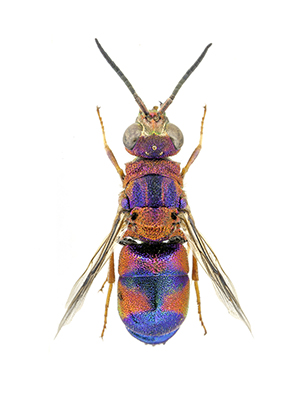Last updated on November 28th, 2023
 From: Kimsey L.S. & Bohart R.M., 1990 (1991) – The chrysidid wasps of the world. Oxford University Press, ix-652 pp.
From: Kimsey L.S. & Bohart R.M., 1990 (1991) – The chrysidid wasps of the world. Oxford University Press, ix-652 pp.
Synonymy
Euchroeus Latreille, 1809: 49. Type: Chrysis purpuratus Fabricius, 1787:283. Monobasic.
Brugmoia Radoszkowski 1877:27. Type: Brugmoia pellucida Radoszkowski 1877:27. Monobasic.
Pseudochrysis Semenov 1891:444. Type: Pseudochrysis virgo Semenov 1891b:44l. (Chrysis singularis Splnola. 1838:452). Desig. by Richards 1935:158.
Generic diagnosis
Face with TFC, usually with two branches extending dorsally toward mid ocellus; tongue long; malar space l MOD or longer; subantennal distance about 2 MOD or longer; mandibles slender, with subapical notch or small subapical tooth; F-I usually less than twice as long as broad; pronotal anterior declivity with four pits; mesopleuron with deep scrobal sulcus subtended by two large acute teeth, usually also with well- developed episternal sulcus; metanotum rounded; fore wing Rs long but bending slightly away from costal margin leaving marginal cell broadly open; T-III usually with large prepit swelling, pits generally subequal to puncture size, apical rim usually with numerous irregular teeth; female ovipositor Segments unmodified. Male terminalia: S-VIII usually broadly rounded apically, gonocoxa short, often with strongly angulate inner margin, cuspis broad and often strongly lobate, digitus slender, aedeagus broadly rounded apically.
Hosts
Unknown.
Distribution
The majority of Euchroeus occur in the western Palearctic Region, and three are Afrotropical.
Discussion
Three related genera, Euchroeus, Spinolia, and Pseudochrysis, share the widely open fore wing marginal cell, together with a well-marked scrobal sulcus. Also, the long and somewhat bulging subantennal space creates a special look to the clypeus. Euchroeus and its relatives, but particularly the Former, are often highly coloured. Females tend to be brassy, coppery pink, or pinkish green. Males are green, blue, of purple. female torrida are remarkably coloured, with a dark blue to green dorsum and brilliant coppery and green face and venter. Two other traits that frequently occur in this genus are the presence of dense long silky pubescence on the venter, and white or translucent yellowish colour on the mandibles, legs, and often on T-III apex. Along with the pale markings, the bispinose mesopleuron below the scrobal sulcus distinguishes Euchroeus from its two related genera. On the other hand, the multiple irregular teeth on the T-III apex are much like those on Spinolia stchurovskyi. Additionally, some Euchroeus (singularis and zarudniana) have only two apicomedial teeth and two lateral teeth on the T-III edge.
The name Euchroeus was considered synonym of Brugmoia by Kimsey & Bohart (1990) « The commonly used name for this genus, Euchroeus, is a generic synonym of Chrysis, based on examination of the type species, purpurata Fabricius (Kimsey 1988b) ». Then, Brugmoia was suppressed by the International Commission of Zoological Nomenclature:
- Pavesi, M. & Strumia, F., 1997 – Euchroeus Latreille, 1809 and Chrysis purpurata Fabricius, 1787 (currently E. purpuratus) (Insecta, Hymenoptera): proposed conservation of usage; and Chrysis gloriosa Fabricius, 1793: proposed suppression of the specific name. Bulletin of Zoological Nomenclature, 54 (1): 26-30.
- ICZN: OPINION 1906, 1998 – Euchroeus Latreille, 1809 (Insecta, Hymenoptera): conserved; Chrysis purpurata Fabricius, 1781 (currently Euchroeus purpuratus): specific name conserved; and Chrysis gloriosa Fabricius, 1793: specific name suppressed. Bulletin of Zoological Nomenclature, 55(3): 194-196.
European species
Copyright, Authorship, and Ownership statements
All text and images of this page are copyright ©️ Chrysis.net unless otherwise stated - please see individual cases for authorship and copyright details. The specimens pictured are from the authors' or other collaborators' personal collections and from the collections of various museums. Unless otherwise specified, the whole content of this web site is for personal, non-commercial, scientific, and educational purposes given proper accreditation to the page from which they were derived are provided, and under Chrysis.net Terms and Conditions.
For citation purposes
Agnoli G.L. & Rosa P. (2025) Genus Euchroeus Latreille, 1809, in: Chrysis.net website. Interim version 22 April 2025, URL: https://www.chrysis.net/database/genus-euchroeus/.




